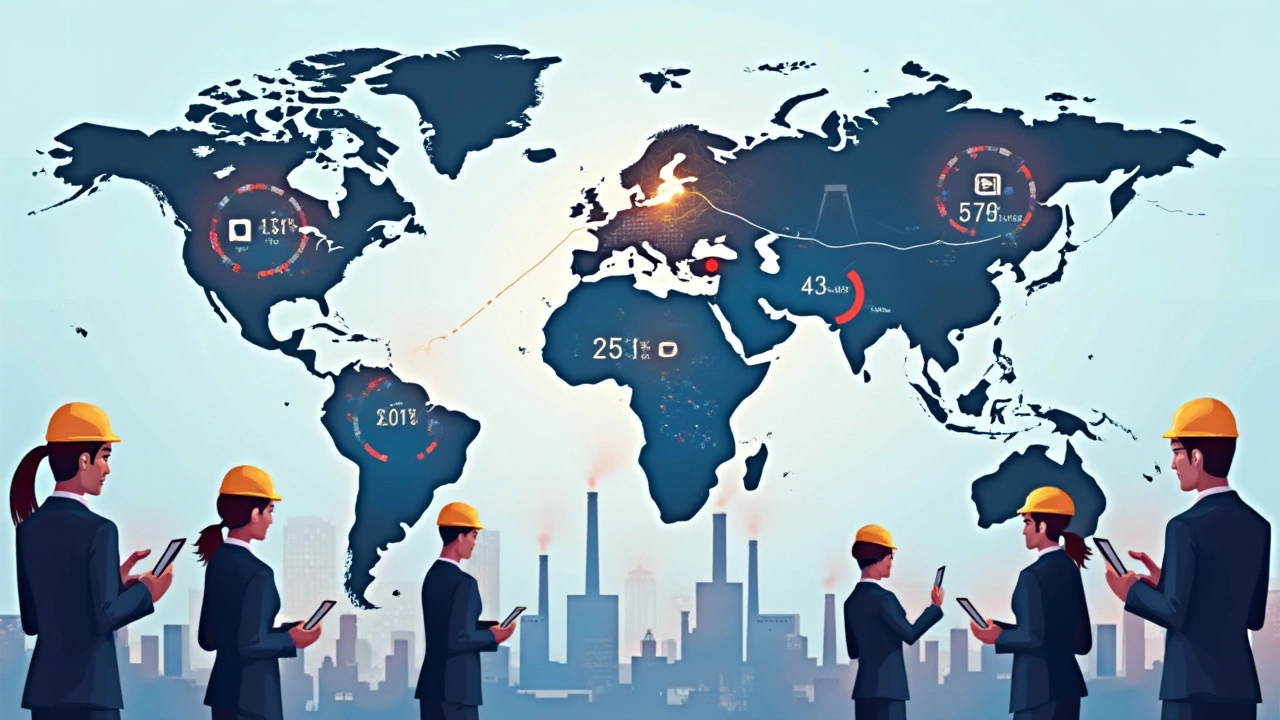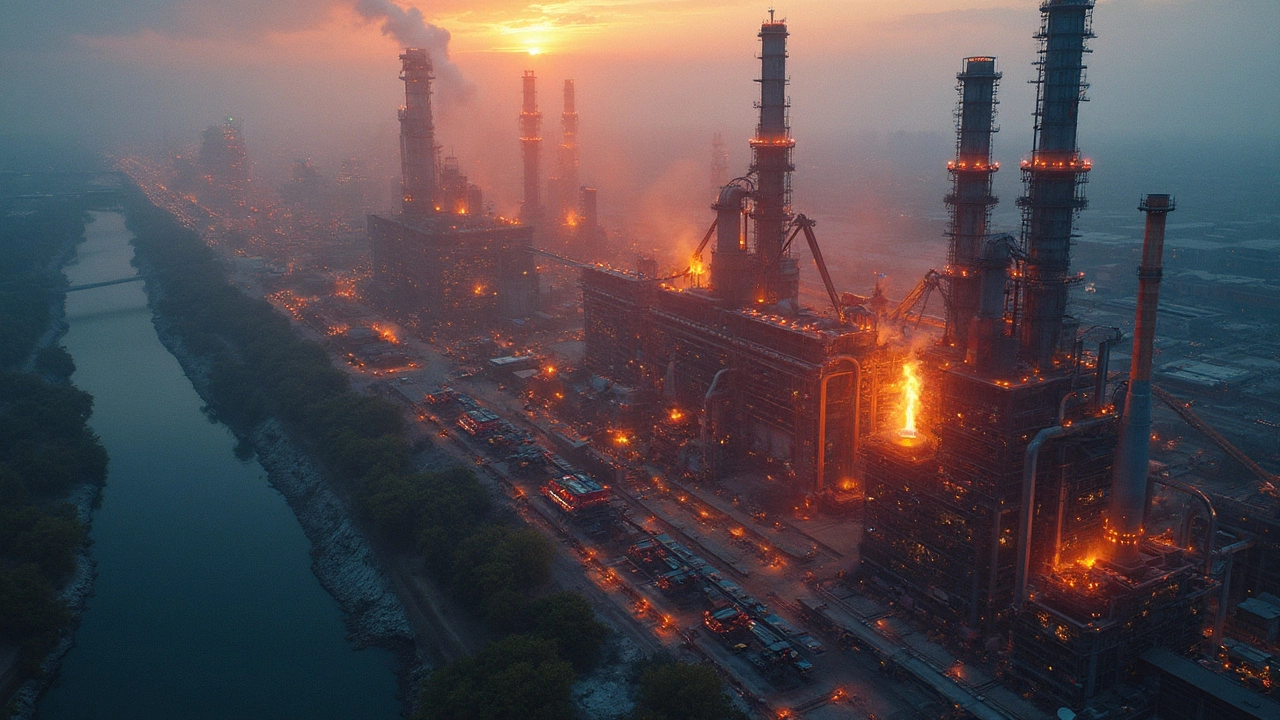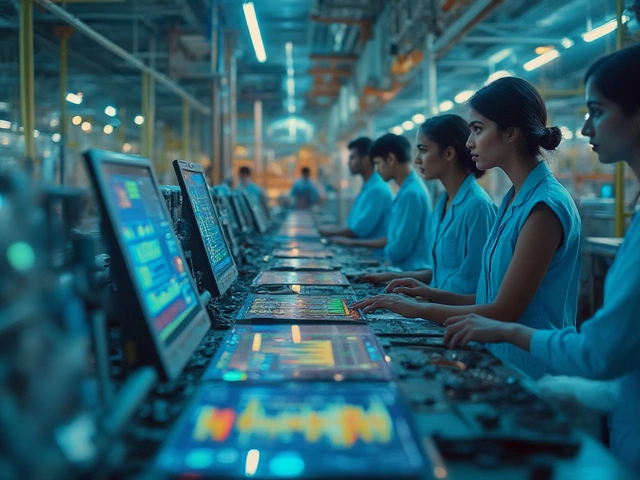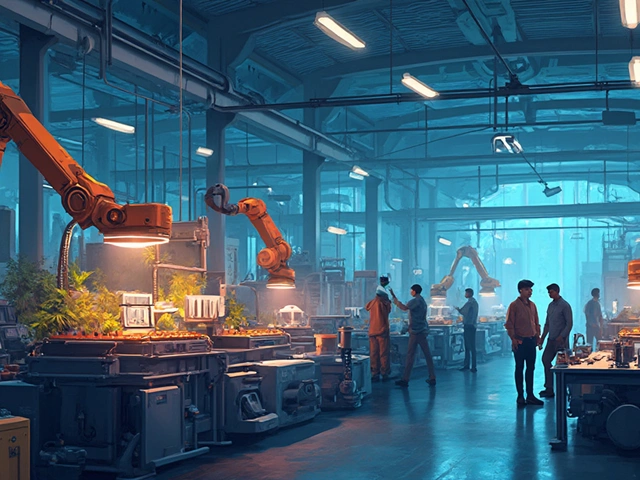If you think steel is just about beams and construction sites, you’re missing out on a wild, impressive world. The top steel plants aren't just huge—they set the pace for everything from car manufacturing to the price of your next fridge. These places run nonstop, using mind–boggling amounts of raw materials and tech that's way more advanced than most people imagine.
Here’s a wild stat: the biggest steel plant cranks out over 40 million tons every year. That’s enough to build dozens of skyscrapers every single day. But it’s not just about size—these plants lead the way in automation, efficiency, and green tech. You’d be surprised how much of your daily life is affected by what happens in factories you’ve probably never heard of.
Whether you’re shopping for new suppliers, working in construction, or just curious how global trade shakes up your local market, knowing about these steel giants puts you ahead of the game. Companies eye the big five when it comes to prices, innovation, and even eco–practices. Looking for tips on how to tap into this market or spot legit suppliers? Stick around; the details will save you time and cash.
- Why Size and Output Matter in Steel Plants
- Inside the Top 5: The World’s Largest Steel Giants
- Smart Tech: How Automation Shapes Modern Steelmaking
- Sustainability Moves: Steel Plants Chasing Green Goals
- Steel Plant Supply Chains: How These Giants Feed the World
- What Smaller Players Can Learn from the Big Five
Why Size and Output Matter in Steel Plants
When it comes to steel plants, size isn’t just about bragging rights. It has a real impact on prices, quality, and even what products end up in your local hardware store. The top steel producers pull off massive economies of scale, which means they spread out costs across a huge volume of steel. This brings down the price per ton, making large plants the go-to for big projects and global supply contracts.
Check out how size shows up in the numbers. Here’s a quick look at the world’s top five steel plants by annual output, all measured in million metric tons:
| Steel Plant | Country | Annual Output (2024, million tons) |
|---|---|---|
| Baowu Steel Group | China | 132 |
| ArcelorMittal | Luxembourg/Worldwide | 68 |
| Shagang Group | China | 44 |
| Nippon Steel | Japan | 41 |
| HBIS Group | China | 38 |
These numbers aren’t small. For example, Baowu pumps out more steel in a year than some entire countries use. Big output like this helps steel plants offer steady supply and absorb shocks, like raw material price swings or changes in demand. If a plant can keep its blast furnaces running at full tilt, it’s usually in a better spot when times get tough.
Also, top plants tend to have more muscle to invest in upgrading their tech or meeting strict environmental rules. Want better quality steel, or steel with a smaller carbon footprint? You’re more likely to find it at a giant producer that has extra cash for new tech and smart processes.
The size of a steel plant also matters for buyers who want reliable supply for huge projects, like building bridges or city metros. Smaller mills can’t always promise the same consistency or the ability to ramp up quickly if demand jumps.
- Lower costs per ton thanks to mass production
- More stable supply chains and delivery reliability
- Better ability to adopt advanced technologies
- Greater resilience against price shocks or market dips
Bottom line: in steel, being big isn’t just for show. It gives these plants real leverage in price, supply, quality, and innovation—stuff that affects everyone from car makers to folks picking out garden fences.
Inside the Top 5: The World’s Largest Steel Giants
These aren’t your average factories. The world’s top steel plants combine massive production volume with cutting-edge technology and smart business moves. Here’s a closer look at where these steel giants are based, how much they churn out, and what makes each one worth watching.
Check out the world’s largest steel plants and their recent stats:
| Rank | Plant Name | Country | Annual Output (Million Tons) | Unique Feature |
|---|---|---|---|---|
| 1 | Baowu Steel Group | China | ~131 | Global leader and tech innovator, formed by the merger of Baosteel and Wuhan Iron & Steel |
| 2 | ArcelorMittal | Luxembourg (plants worldwide) | ~68 | Most diversified, with plants on every continent |
| 3 | Hesteel Group | China | ~42 | Leads Asia’s construction steel production |
| 4 | Nippon Steel Corporation | Japan | ~37 | Known for high-quality steel and major exports |
| 5 | Shagang Group | China | ~34 | China’s largest private steel producer |
So, what pushes these companies to the top? Size is just the start. Baowu Steel Group, for example, isn’t just the biggest—they’re setting the pace in the industry’s shift to digital production. Baowu rolled out the Smart Steel Factory concept, using sensors and AI to ramp up efficiency and cut waste. You’ll find similar ambition at ArcelorMittal, which keeps its edge by spreading its risks, owning plants all over the globe from Poland to the U.S.
If you’re dealing with construction or automotive supply, you’ve probably run into Hesteel Group steel without even knowing it. They set industry standards for rebar quality and ship tons of it across Asia. Nippon Steel pushes for quality over quantity—look at any major Japanese car, and you’re looking at their handiwork. Shagang Group, meanwhile, keeps things nimble as a private player, reacting fast to market shifts.
Choosing a supplier from these giants? Here’s a tip: reliability isn’t just about numbers. Look at which ones are investing in green tech, or who can deliver custom specs. They’ve all got the capacity, but the extra value comes in service and consistency. When you’re hunting for the best deal or the most advanced features, start with this steel plants shortlist and dive deeper based on your specific needs.
Smart Tech: How Automation Shapes Modern Steelmaking
It’s honestly hard to picture modern steel manufacturing without automation. The top steel plants invest billions in smart tech because it makes the whole process faster, safer, and surprisingly less wasteful. When you walk through one of these plants, you see a crazy amount of robots, sensors, AI controls, and even drones checking on gigantic blast furnaces—all so the steel keeps coming out strong and consistent.
Let’s look at some real upgrades these giants have put in place:
- Robotic arms handle red-hot steel slabs, cutting down on risk and speeding things up.
- AI-powered quality checks spot micro-cracks nobody’s eye could catch, slashing defects.
- Automated vehicles move finished products around the plant floor with almost zero mistakes.
- Cloud systems collect data nonstop, helping fix problems before they turn expensive.
For example, POSCO in South Korea invested heavily in smart sensors that monitor temperature, pressure, and chemical vibes in every furnace. These sensors track over 100 variables in real time and feed that data into one main computer, which tweaks the whole process if things look off. ArcelorMittal’s facilities in Belgium and Spain have gone all out with "digital twins"—basically a full simulation of their real plant running on a computer, so engineers can predict issues, test changes, and do maintenance at the perfect moment.
If you want to see how far automation has moved the needle, check out this simple table:
| Plant Name | Robots per 1,000 Workers | Downtime Reduced | Defect Rate |
|---|---|---|---|
| POSCO (Korea) | 18 | 25% | 0.7% |
| Baowu Steel (China) | 14 | 20% | 1.1% |
| ArcelorMittal (Belgium/Spain) | 19 | 28% | 0.6% |
These upgrades aren’t just about bragging rights. Plants with better automation get products out the door faster, with fewer mistakes. That’s why anyone looking for a supplier should look at the "smart tech" side and not just chase the cheapest price. If a plant is one of the top steel manufacturers, automation probably plays a big role in their success—it means more reliable delivery and better quality.

Sustainability Moves: Steel Plants Chasing Green Goals
The steel industry has a tough reputation for being one of the world’s biggest polluters. But some of the top steel plants are flipping the script and making real moves toward greener production. Think solar panels on roofs, electric arc furnaces, and smarter ways to use water and scrap metal. It isn’t just talk either. For leaders in steel, a smaller carbon footprint means saving cash, attracting responsible customers, and sometimes dodging tight government rules on emissions.
ArcelorMittal, for example, set out to slash its CO2 emissions across all plants by 35% by 2030, focusing big time on hydrogen as a clean alternative to coal. China's Baowu Steel Group, the world’s largest, rolled out an entire "green steel" line and uses recycled scrap for over 20% of its total production. Plants like POSCO in South Korea are rolling high on smart technology—using artificial intelligence to cut waste and energy use in real time.
Here’s a look at what these top steel manufacturers are doing to keep things sustainable:
- Swapping Coal for Hydrogen: Some sites are now using hydrogen instead of coal to reduce harmful gas emissions (especially CO2), which is a total game-changer.
- Electric Arc Furnaces: Replacing old-school blast furnaces with electric arc versions helps use more recycled steel and slashes overall emissions.
- Smart Recycling: The best plants gather their own waste steel, melt it down, and feed it back into the process, cutting the need for new, mined materials.
- AI and Automation: Automation helps cut power use, spot leaks, and fine-tune energy flows faster than any human could.
If you’re a numbers guy, check out this quick breakdown. The top five steel companies are already making noticeable cuts—here’s how much CO2 they save or plan to save by 2030:
| Steel Plant | Targeted CO2 Emission Reduction | Sustainability Tech Highlights |
|---|---|---|
| ArcelorMittal | 35% cut by 2030 | Hydrogen pilot plants, carbon capture |
| Baowu Steel Group | 30% cut by 2035 | Recycled scrap steel, direct reduction tech |
| Nippon Steel | 30% cut by 2030 | Electric arc furnaces, waste heat recovery |
| POSCO | 37% cut by 2030 | AI-powered smart plants, hydrogen steelmaking |
| JFE Steel | 20% cut by 2030 | Efficient water reuse, electric arc tech |
If you’re running a construction company, just getting into the industry, or even looking to invest, watch what these steel giants are doing to clean up their act. It affects product choices, prices, and even government funding in certain regions. The race to go green is changing not just the image of steel, but also the way business gets done worldwide.
Steel Plant Supply Chains: How These Giants Feed the World
Ever wonder how the steel from Asia ends up in buildings in New York or car factories in Germany? The biggest steel plants run some of the world’s most complex supply chains. It all kicks off with raw materials like iron ore, coal, and limestone, often sourced from different continents. These resources get shipped to port cities with massive docks and direct rail lines to the factories. It’s not just local trucking—think fleets of ships, miles of rails, and storage yards the size of airports.
Once the steel is made, the real journey begins. Steel from the world’s top plants—like ArcelorMittal in India, Baowu in China, and POSCO in South Korea—is sent worldwide. They supply car makers, appliance companies, shipyards, and construction firms across at least five continents. What’s wild is how the timing works: plants track orders to the minute, loading trains and ships so that a steel coil made in China could reach a Detroit assembly line in under two weeks.
Check out this data from 2024—it shows just how much steel these giants push out globally:
| Steel Plant | Annual Exports (Million Tons) | Main Export Markets |
|---|---|---|
| ArcelorMittal | 56 | Europe, North America, South America |
| China Baowu Group | 52 | Asia, Middle East, Africa |
| Nippon Steel | 35 | Japan, SEA, US |
| POSCO | 34 | Asia, US, EU |
| Hesteel Group | 28 | China, SEA, Africa |
Here are a few key things that keep these supply chains running smoother than you’d expect:
- Tech for tracking: The biggest plants use real-time shipment tracking, so buyers always know where their steel is.
- Flexible logistics: They switch between ships, trains, and trucks depending on weather, strikes, or sudden demand spikes.
- Local warehouses: To cut lead times, they store popular products in regional warehouses, getting orders out in days, not weeks.
- Long-term deals: Most big customers lock in supply agreements for years, which helps stabilize prices even when markets get rocky.
If you’re looking to source from these steel giants, pro tip: check if they have regional offices or authorized local distributors. It can shave weeks off delivery and help handle paperwork headaches. The scale at which these plants operate is nuts, but it’s the supply chain magic that truly keeps the world’s construction and manufacturing wheels spinning.
What Smaller Players Can Learn from the Big Five
It’s easy to think that these steel giants are in a different league, but smaller plants aren’t cut off from their playbook. The big five set major trends in the steel plants game, but what works for them often pays off for smaller factories too—just on a different scale. The trick is to spot what’s actually doable without going broke.
The heavy hitters nail a few things that smaller players can totally copy:
- Automate Smart: You don’t need an army of robots, but even basic automation tools—think sensor-based temperature controls or software for tracking inventory—work wonders. ArcelorMittal, for example, cut energy costs by 8% after rolling out real-time monitoring systems.
- Waste Less: Nippon Steel slashed its waste by recycling every scrap back into the furnace. Smaller plants can start simple by sorting and reusing leftover metal, which saves cash and wins eco-points with customers.
- Team Up: The giants survive shocks by locking in supply deals and sharing logistics. Smaller plants can join local buyers’ groups or share trucking contracts to lower costs and avoid shipping headaches.
- Keep Learning: China Baowu and others send crews for continuous training. Small shops should look for quick online courses or even free webinars to keep up with new tech or regulations.
Even with less firepower, these moves give smaller steel operations a fighting chance. Here’s a quick breakdown showing what big plants pull off, and how smaller ones can get a piece of it:
| Strategy | Big Five Example | Smaller Plant Tactic |
|---|---|---|
| Energy Efficiency | POSCO uses predictive AI for furnace control | Basic furnace timers and better insulation |
| Supply Chain Resilience | JFE Steel’s global shipping contracts | Local carrier partnerships and flexible suppliers |
| Staff Training | China Baowu’s in–house training university | Local workshops, webinars, or manufacturer support |
| Waste Reduction | Nippon Steel’s zero landfill policy | Sorting scrap metal, selling or reusing waste |
The main thing? Get inspired but keep it practical. Not every upgrade requires deep pockets—just a sharper eye for where you’re losing money or lagging behind. The big guys might be running at full throttle, but their best ideas scale down more than you’d think.






